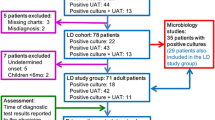Abstract.
The aim of this prospective study was to compare patient characteristics, clinical data, and evolution of Legionella pneumophila pneumonia according to the duration of Legionella urinary antigen excretion. Urine samples from 61 patients with Legionella pneumonia diagnosed by detection of urinary antigen were obtained periodically until urinary antigen could no longer be detected. Cases were divided into two groups based on the duration of urinary antigen excretion: group I (46 patients, <60 days) and group II (15 patients, ≥60 days). Groups were compared for patient characteristics, clinical data, and evolution of pneumonia. Antigen excretion ≥60 days was observed significantly more frequently in immunosuppressed patients (P=0.001) in whom the time to apyrexia was >72 h (P=0.002), although only the time to apyrexia remained significant on multivariate analysis (P=0.006). In conclusion, the duration of Legionella urinary antigen excretion was <60 days in most patients but was longer in immunosuppressed patients with a longer time to defervescence of fever.

Similar content being viewed by others
References
Ruf B, Schurmann D, Horbach I, Fehrenbach FJ, Pohle HD (1990) Prevalence and diagnosis of Legionella pneumonia: a 3-year prospective study with emphasis on application of urinary antigen detection. J Infect Dis 162:1341–1348
Yu VL (2000) Legionella pneumophila (Legionnaires' disease). In: Mandel GL, Bennett JE, Dolin R (eds) Principles and practice of infectious disease. Churchill Livingstone, Philadelphia, pp 2424–2435
Plouffe JF, File TM Jr, Breiman RF, Hackman BA, Salstrom SJ, Marston BJ, Fields BS, the Community-Based Pneumonia Incidence Study Group (1995) Reevaluation of the definition of Legionnaires' disease: use of the urinary antigen assay. Clin Infect Dis 20:1286–1291
Waterer GW, Baselski VS, Wunderink RG (2001) Legionella and community-acquired pneumonia: a review of current diagnostic tests from a clinician's viewpoint. Am J Med 110:41–48
Sopena N, Sabrià M, Pedro-Botet ML, Manterola JM, Matas L, Domínguez J, Modol JM, Tudela P, Ausina V, Foz M (1999) Prospective study of community-acquired pneumonia of bacterial etiology in adults. Eur J Clin Microbiol Infect Dis 18:852–858
Roson B, Carratala J, Verdaguer R, Dorca J, Manresa F, Gudiol F (2001) Prospective study of the usefulness of sputum Gram stain in the initial approach to community-acquired pneumonia requiring hospitalization. Clin Infect Dis 31:869–874
Modol JM, Pedro-Botet ML, Sabriá M, Gimeno JM, Prats R, Nieto J, Sopena N (1998) Environmental and clinical legionellosis in hospital in Catalonia, Spain. In: Program and abstracts, 38th Interscience Conference on Antimicrobial Agents and Chemotherapy, abstract no. K-49a
Alvarez J, Oyaga N, Escofet D, Codony F, Orcau A, Maria Oliva J (2001) Community-acquired legionellosis in the Barcelona (Spain) region between 1992 and 1999: epidemiological characteristics and diagnostic methods. Med Clin (Barc) 117:495–496
Domínguez JA, Materola JM, Blavia R, Sopena N, Belda FJ, Padilla E, Giménez M, Sabrià M, Morera J, Ausina V (1996) Detection of Legionella pneumophila serogroup 1 antigen in non-concentrated urine and concentrated by selective ultrafiltration. J Clin Microbiol 34:2334–2336
Domínguez JA, Matas L, Manterola JM, Blavia R, Sopena N, Belda FJ, Padilla E, Giménez M, Sabrià M, Morera J, Ausina V (1997) Comparison of radioimmunoassay and enzyme immunoassay kits for detection of Legionella pneumophila serogroup 1 antigen in both concentrated and non-concentrated urine samples. J Clin Microbiol 35:1627–1629
Dominguez JA, Gali N, Pedroso P, Fargas A, Padilla E, Manterola JM, Matas L (1998) Comparison of the Binax Legionella urinary antigen enzyme immunoassay (EIA) with the Biotest Legionella urine antigen EIA for detection of Legionella antigen in both concentrated and nonconcentrated urine samples. J Clin Microbiol 36:2718–2722
Stout JE, Yu VL (1997) Legionellosis. N Eng J Med 337:682–687
Kohler RB, Winn WC, Wheat LJ (1984) Onset and duration of urinary antigen excretion in Legionnaires disease. J Clin Microbiol 20:605–607
Morley JN, Smith LC, Baltch AL, Smith RP (1994) Recurrent infection due to Legionella pneumophila in a patient with AIDS. Clin Infect Dis 19:1130–1132
Health CH, Grove DI, Looke DFM (1996) Delay in appropriate therapy of Legionella pneumonia associated with increased mortality. Eur J Clin Microbiol Infect Dis 15:286–290
Edelstein PH (1999) Antimicrobial chemotherapy for Legionnaires' disease: a review. Clin Infect Dis 21 [Suppl 3]:265–276
Author information
Authors and Affiliations
Corresponding author
Additional information
This article was presented in part at the 39th Interscience Conference on Antimicrobial Agents and Chemotherapy, San Francisco, September 1999.
Rights and permissions
About this article
Cite this article
Sopena, N., Sabrià, M., Pedro-Botet, M.L. et al. Factors Related to Persistence of Legionella Urinary Antigen Excretion in Patients with Legionnaires' Disease. Eur J Clin Microbiol Infect Dis 21, 845–848 (2002). https://doi.org/10.1007/s10096-002-0839-5
Published:
Issue Date:
DOI: https://doi.org/10.1007/s10096-002-0839-5




